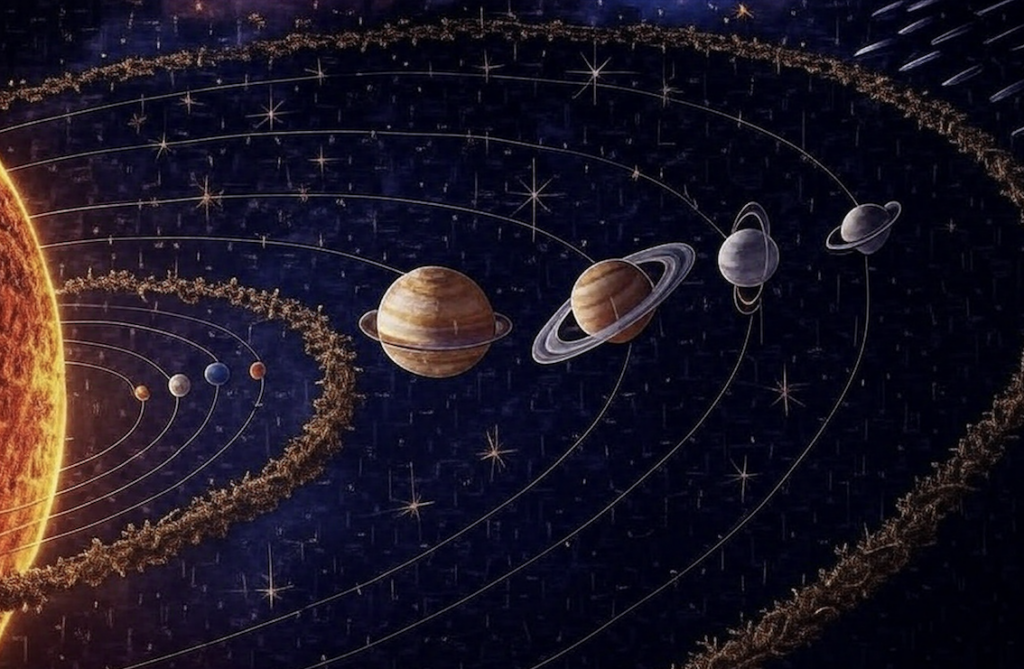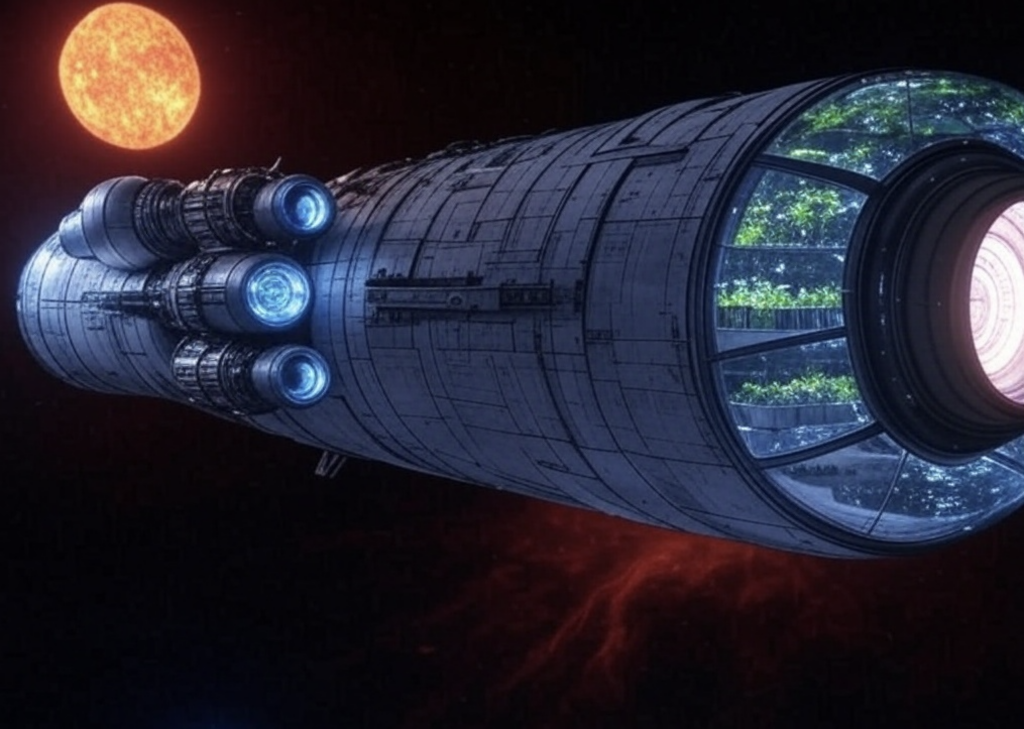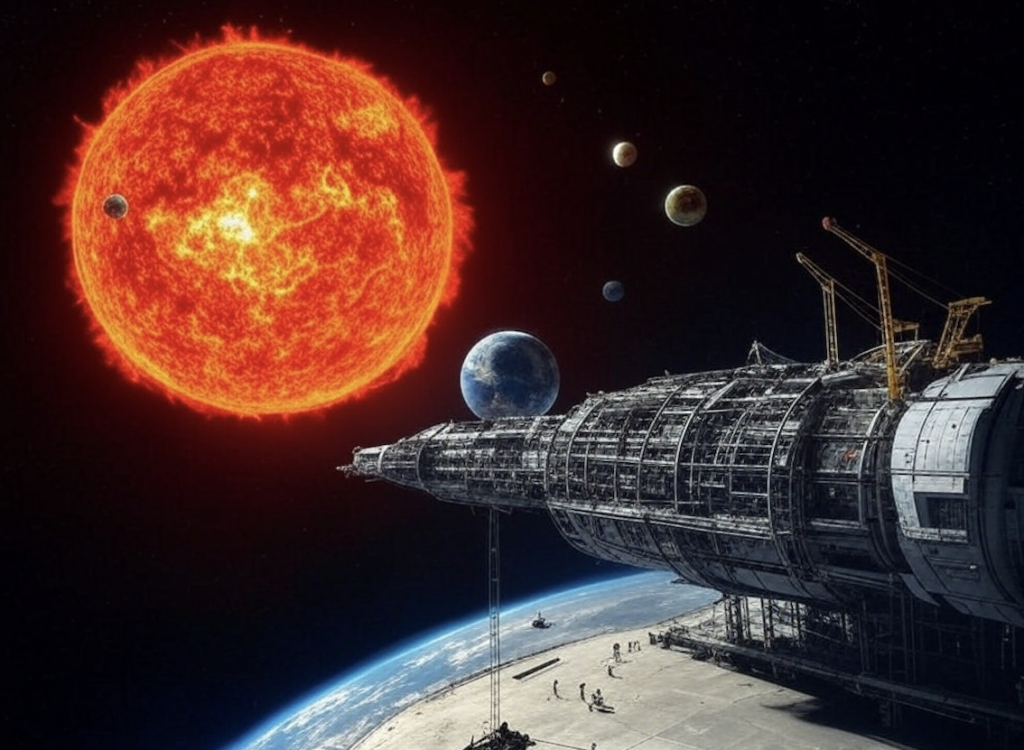The Sun powers our world, but it won’t last forever. In 5 billion years, it’ll swell into a red giant, roasting Earth. Could we flee to Mars or Neptune? Or better yet, build a giant ship with a “tiny sun” to leave the Solar System entirely? Let’s dive into the Sun’s fiery heart, Earth’s molten core, and a wild plan to become interstellar nomads.
Red Giant Doom: Mars or Neptune?
When the Sun expands to 1-2 AU, Earth’s toast—possibly swallowed or fried at 1,000°C. Mars (1.5 AU) might warm briefly to Earth-like temps before roasting. Neptune (30 AU) could heat from -201°C to -50°C or 0°C as the Sun shines 5,000 times brighter—maybe habitable with insane tech, but its gas-giant nature makes it a stretch. Neither’s a real fix.

Escape Plan: A Ship with a Tiny Sun
Why not ditch the Solar System? Picture a 50 km-long, spinning ship (1g gravity) powered by not one, but two fusion reactors—our “tiny suns.” Here’s the blueprint:
- Fusion Engines: Dual 5-terawatt reactors fuse deuterium and tritium (from water ice and lithium). Two mean redundancy—if one’s down, the other keeps us alive. Maintenance? Shut one off (cut fuel, collapse magnetic fields, cool in minutes), then robots swap worn coils or tiles every month. Fuel comes from onboard stocks or comet ice.
- Speed: Ion thrusters accelerate at 0.01g, hitting 5% lightspeed (15,000 km/s) in years. To slow, reverse thrust or unfurl 100 km-wide magnetic sails, braking over decades.
- Food: 10 km² of hydroponic farms grow wheat, soy, and algae; aquaponics raise fish and chickens. Robots prune, crew preserves surplus—2,000 calories/person/day for 1 million souls.
- Waste: Humans and animals produce 550 tons yearly. Composters turn 90% into fertilizer; water’s recycled via evaporators. Excess? Compress into bricks for shielding or farm use. Maintenance: Clean filters, stir compost weekly.
- Repairs: Drones patch hulls with asteroid metals; AI predicts failures. Harvest comets every decade—melt ice for fuel, smelt nickel for parts.

Phase 1: Preparation (0-100 Years from Now)
Goal: Develop technology for a robust, maintainable interstellar ark.
- Fusion Research: Design two compact fusion reactors (5 terawatts each) for redundancy—deuterium-tritium tokamaks, 100 meters wide. Include shutdown protocols: magnetic fields collapse via controlled power cuts, cooling plasma in minutes.
- Space Industry: Orbital shipyards mine lunar iron and asteroid water, stockpiling spares (coils, hull plates).
- Ship Design: 50 km-long, 10 km-wide rotating cylinder (1g via 0.13 RPM spin). Two fusion engines at opposite ends for balance and backup.
- Propulsion: Fusion-powered ion thrusters (0.01g thrust). Acceleration: ramp up ion exhaust velocity; deceleration: reverse thrust or deploy magnetic sails.
- Recycling Systems: Water purifiers, air scrubbers, and waste processors (human/animal waste into fertilizer).
- Food Systems: Plan hydroponic farms and small livestock (chickens, fish) for 100,000-1 million people.
- Fuel: Harvest 10,000 tons of deuterium and lithium from Earth.
Phase 2: Construction (100-500 Years)
Goal: Build a ship with dual engines, food production, and waste management.
- Location: L5 Lagrange point, near asteroid resources.
- Materials: Moon and asteroid metals/water. Hull uses self-repairing alloys.
- Tiny Suns (Fusion Engines):
- Two Engines: Install two reactors—primary for power/thrust, secondary as backup. If one fails, the other sustains life and propulsion.
- Shutdown for Maintenance: Divert power to capacitors, then cut fuel injection (deuterium-tritium flow stops). Magnetic fields collapse in 5-10 minutes, cooling plasma to safe levels. Robots replace worn parts (coils, tiles) in 1-2 weeks.
- Specs: Each produces 5 terawatts, powering habitat lights and thrusters.
- Propulsion:
- Acceleration: Increase ion thruster output (more fusion energy to ionize propellant like xenon or hydrogen). Reach 5% lightspeed (15,000 km/s) after years of 0.01g thrust.
- Deceleration: Reverse thrusters (expel ions forward) or deploy magnetic sails (100 km-wide loops) to brake against stellar winds/particles. Slow from 15,000 km/s to zero over decades.
- Food Systems: Build 10 km² of hydroponic farms (wheat, soy, algae) and aquaponics (fish, shrimp). Maintenance: Robots prune plants, clean tanks; crew monitors nutrient levels.
- Waste Management:
- Human/Animal Waste: Composting reactors break down feces/urine into nitrates and water. Maintenance: Stir compost weekly, replace filters monthly.
- Storage: Excess solids compressed into bricks for fertilizer or radiation shielding.
- Rock Harvesting: Magnetic scoops and lasers grab asteroids/comets for water (fuel), metals (repairs), and carbon (food nutrients).

Phase 3: Launch Prep (500-1,000 Years)
Goal: Test and refine maintenance, food, and waste systems.
- Timing: Launch in 4-5 billion years as the Sun nears red giant phase.
- Crew: Train engineers for engine shutdowns, farmers for food, and techs for waste/recycling.
- Maintenance Systems:
- Ship: Drones patch hull with asteroid metals; sensors flag stress.
- Fusion Engines: Practice shutdowns—alternate engines monthly, repairing one while the other runs. Stock 1,000 tons of spares (coils, shielding).
- Recycling: Replace water filters yearly; test air scrubbers with animal waste.
- Propulsion Tests:
- Acceleration: Run thrusters at 0.005g, then 0.01g, checking crew comfort (1g spin + thrust = slight tilt).
- Deceleration: Simulate braking with reverse thrust and mock sails in orbit.
- Food Systems:
- Stock: Load seeds, fish eggs, and 1,000 chickens. Test yields—aim for 2,000 calories/person/day.
- Maintenance: AI tracks crop health; crew rotates soil microbes.
- Waste Management:
- Human: 1 million people produce ~500 tons of waste yearly. Compost 90%, recycle water.
- Animal: Chickens/fish waste (50 tons/year) composted or fed to algae.
- Redundancy: Backup processors handle overflow.
Phase 4: Exodus (Launch Day)
Goal: Depart with all systems operational.
- Trajectory: Exit ecliptic at 5% lightspeed toward Proxima Centauri (80-year trip).
- Power: Dual engines run—primary for thrust, secondary for habitat. Shutdown one monthly for maintenance, alternating.
- Acceleration: Ramp thrusters to 0.01g over weeks, hitting 15,000 km/s in 5 years.
- Life Aboard:
- Food: Farms produce grains, veggies, fish; chickens lay eggs. Crew eats 2-3 meals/day.
- Waste: Toilets pipe waste to composters; drones move fertilizer to farms.
Phase 5: Interstellar Journey (1,000+ Years)
Goal: Maintain ship, engines, food, and waste across generations.
- Ship Maintenance: Drones weld hull patches; crew reinforces spin bearings.
- Fusion Engine Maintenance:
- Two Engines: Run one, service the other. Shutdown: Cut fuel, collapse fields, cool for 2 weeks. Robots swap neutron-damaged tiles (1-2 tons replaced yearly).
- Fuel: Harvest comet ice (10-100 tons/flyby) for deuterium; breed tritium in lithium blankets (replaced every 50 years).
- Propulsion:
- Acceleration: Adjust thrust for course corrections (e.g., dodge debris).
- Deceleration: At 40 years out, reverse thrusters (0.01g) or deploy sails, slowing over 40 years to orbit Proxima.
- Food Systems:
- Production: Farms yield 730,000 tons/year for 1 million. Fish ponds cycle nutrients; chickens bred for meat/eggs.
- Maintenance: Robots fix irrigation pipes; crew preserves surplus (drying, freezing with fusion power).
- Waste Management:
- Human: 500 tons/year composted—90% to farms, 10% stored as bricks. Water recycled via evaporators.
- Animal: 50 tons/year from livestock processed into fertilizer or biogas (powers backup systems).
- Overflow: Excess gas vented or burned; solids compressed.
- Rock Harvesting: Catch 1-2 comets/decade—melt ice for water/fuel, smelt metals for repairs, extract nitrogen for food.
Phase 6: Arrival (Optional, 80+ Years Post-Launch)
Goal: Settle or drift, fully maintained.
- Deceleration: Reverse thrust slows ship to 100 km/s, then sails brake to orbital speed. Maintenance: Clear thruster nozzles, mend sails.
- Settlement: Orbit Proxima’s planet or build bases with harvested materials.
- Food/Waste: Farms and composters sustain life indefinitely if drifting.
Could It Work?
With fusion mastered (centuries off today), yes! Two engines ensure power, maintenance keeps it running, and harvesting sustains us. Challenges? Tech gaps, radiation, human endurance—but it beats roasting. A group of rocks won’t make a Sun (needs hydrogen mass), but enough mass could birth a black hole. Our ship sidesteps both, chasing new stars.